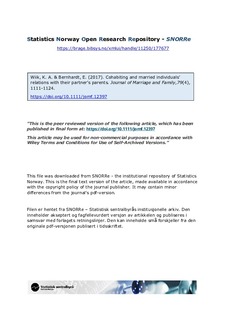| dc.contributor.author | Wiik, Kenneth Aarskaug | |
| dc.contributor.author | Bernhardt, Eva | |
| dc.coverage.spatial | Norge / Norway | nb_NO |
| dc.date.accessioned | 2018-11-14T18:56:21Z | |
| dc.date.available | 2018-11-14T18:56:21Z | |
| dc.date.issued | 2017-04-21 | |
| dc.identifier.citation | Wiik, K. Aa. and Bernhardt, E. (2017), Cohabiting and Married Individuals' Relations With Their Partner's Parents. Journal of Marriage and Family, 79(4), 1111-1124. | nb_NO |
| dc.identifier.issn | 1741-3737 | |
| dc.identifier.uri | http://hdl.handle.net/11250/2572928 | |
| dc.description.abstract | Using Norwegian survey data on partnered individuals ages 18 to 55 (N = 4,061; 31% cohabitors), the current study investigated differences across marital and cohabiting unions regarding the patterns of contact with the parents of the partner. In addition to investigating the frequency of such contact, we assessed the nature of and perceived quality of contacts with the partner's parents. The authors grouped respondents according to whether they had children with their partner and controlled for a range of selection characteristics. Results confirmed that parents with preschool children met their in‐laws more frequently than the childless, irrespective of union type. Married respondents as well as cohabitors with preschool children reported better relations with their partner's parents than childless cohabitors. Taken together, the results imply that having small children was more decisive for the relationship with the parents of the partner than getting married, particularly with regard to contact frequency. | nb_NO |
| dc.language.iso | eng | nb_NO |
| dc.publisher | Wiley | nb_NO |
| dc.subject | Ektepar | nb_NO |
| dc.subject | Samboere | nb_NO |
| dc.subject | Sosiale relasjoner | nb_NO |
| dc.subject | Norge | nb_NO |
| dc.subject | Foreldre | nb_NO |
| dc.subject | Familier | nb_NO |
| dc.subject | Samhandling | nb_NO |
| dc.subject | Familiesosiologi | nb_NO |
| dc.subject | Besteforeldre | nb_NO |
| dc.title | Cohabiting and married individuals' relations with their partner's parents | nb_NO |
| dc.type | Journal article | nb_NO |
| dc.type | Peer reviewed | nb_NO |
| dc.description.version | acceptedVersion | nb_NO |
| dc.rights.holder | © 2017 National Council on Family Relations / John Wiley & Sons publications | nb_NO |
| dc.subject.nsi | VDP::Samfunnsvitenskap: 200::Demografi: 300 | nb_NO |
| dc.subject.nsi | VDP::Samfunnsvitenskap: 200::Sosiologi: 220 | nb_NO |
| dc.source.pagenumber | 1111-1124 | nb_NO |
| dc.source.volume | 79 | nb_NO |
| dc.source.journal | Journal of Marriage and Family | nb_NO |
| dc.source.issue | 4 | nb_NO |
| dc.identifier.doi | https://doi.org/10.1111/jomf.12397 | |
| dc.relation.project | Financially supported by the Swedish Research Council (grant number 2014-1668, “Cohabitation and Family Complexity”) and the Research Council of Norway (grant number 236926). | nb_NO |
